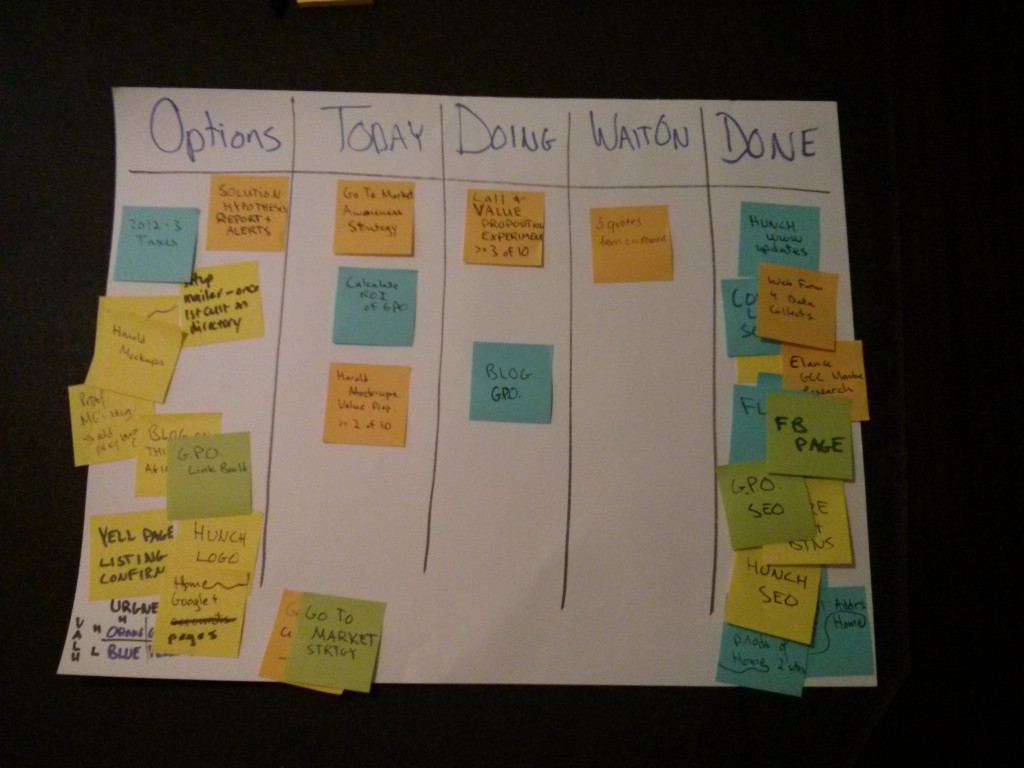

After recently attending the Agile Conference in TorontoI took what I learned in a session on Personal Kanban and combined it with a Priority Matrix that I like to use. The results, thus far, have been amazing and I don’t think I can chalk it up to coincidence. I predict with great confidence that the regular practice of this method will cause your own personal effectiveness / responsibility area to realize a substantial boast. Let me explain how it works.
Priority Matrix
The Priority Matrix I like to use classifies tasks through a lens of its value-add and urgency. A task is either high or low value-add and high urgency or low urgency. When you’ve chosen which it assign it, it falls into the quadrant of the 2 x 2 matrix below. I will be using colors green, yellow, orange, and red to represent each combination. For example, orange is low value add and high urgency.
How do you know if a task if high urgency? I would assign a high urgency to a task that must be done in the next two days and would have an adverse impact to your business if not completed in time.
How do you know if a task is high value add? This can sometimes be a bit harder to determine. I tend to rely on evaluating if the task by asking, “Is this task something I want more of?”. For instance, is the task going to bring in more sales or cut operation costs? If its a task which points to a issue, like a critical bug discovered overnight that impacts your 4th top customer. Maybe its occurred twice now and it’s a systemic problem that needs a root cause analysis to be solved. Perhaps it could be argued it may impact your business ability to sign a longer support deal. However, its not something you want more of. It does sound like it has urgency and therefore I would put this one into the Orange category.
| Urgency | ||
|---|---|---|
| Value | High | Low |
| High | ||
| Low | ||
Taken together the priority matrix analysis delivers an effective, easy-to-follow, easy-to implement process. Learn the process and it allows you to be more effective. Plan, organize and do what needs to be done when it needs to be done.
Kanban Board
If you come from the Software world, this shouldn’t be new to you. Kanban is a Japanese word used to help in Lean or Just-In-Time scheduling systems. The Agile software world subsequently adopted the method and term to help through-put of software delivery operations. Often utilizing sticky notes, whiteboards, the kanban board aids iterative software cycles to focus on tasks in queue, work-in-progress and complete. The following diagram shows a simple example:
The purpose of kanban board is to help stakeholders visualize the workflow, to limit work-in-progress, to pull work from column to column and finally to monitor, adapt and improve your software process. As an idea, it can be applied to anything, including marketing, sales, and automotive since the idea originated with Toyota.
Priority Matrix Meets Kanban
Coupled with a Personal Kanban board. the priority matrix can be integrated with a color coded sticky not scheme. Knowing the colors which are most important to your business success you can quickly visualize where you should be spending your time. Visually, you can get insights into the number of low value non-urgent tasks that you’ve spinning your wheels on. It reinforces the high value urgent tasks since those red tasks stare at you every time you think about picking off the green (low value not urgent tasks). Using these simple tools and process, our management team experience has been great, and I’m convinced its a tremendous keystone habit.
 Priority based Kanban board example
Priority based Kanban board exampleSome final notes:
- These assume a task takes up to several hours to complete. Certainly if it requires more than day, you should break it into subtasks.
- Putting your tasks into sticky notes also gets them out of your head which improves your focus since you don’t have to remember everything.
- A board that’s up in the office or coffee room allows for your advisors to see where you’re spending time and makes it easy for them to make suggestions.
- In a team setting, the benefits of the kanban board go beyond the scope of this article, and has a bunch of benefits for team effectiveness, cohesion and the like. Search around, there’s lots more resources on Agile, Kanban, but I’d be surprised if you find another priority matrix combined in this way.

